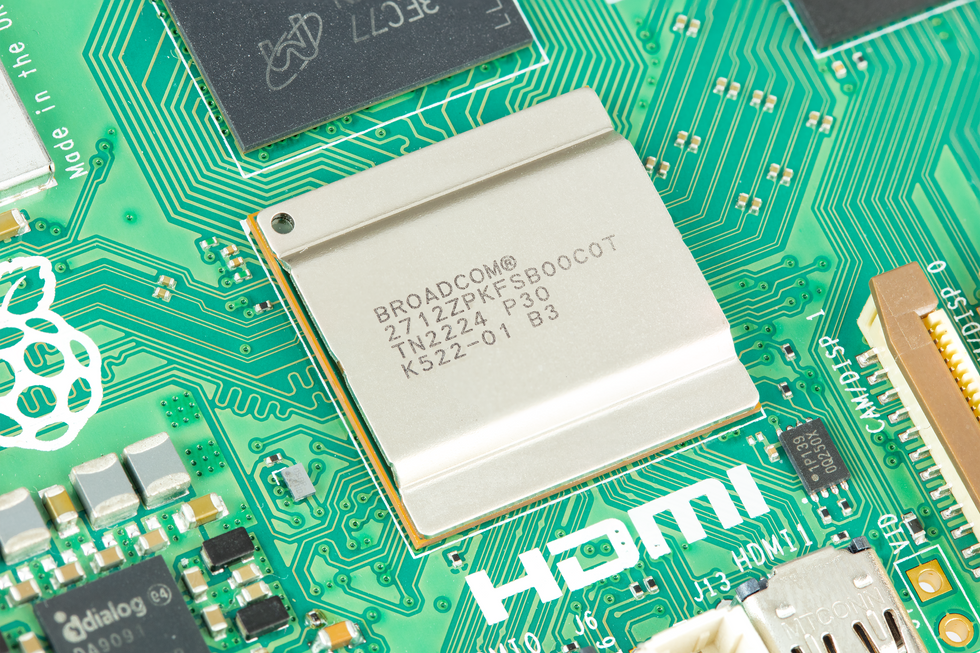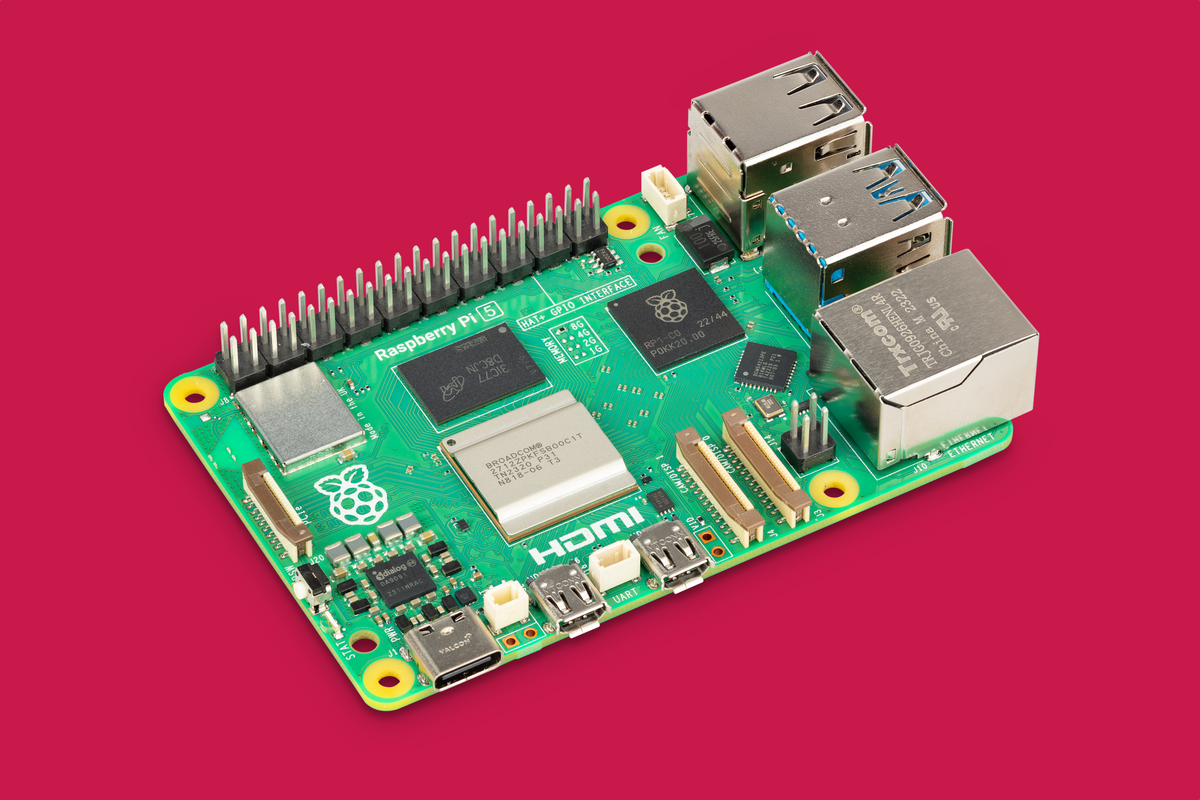Toss your desktop in the bin. The Raspberry Pi 5 is here.
The thought of replacing a desktop or laptop with a single-board computer (SBC) might seem odd. But the Raspberry Pi 5, the latest in the long-running Raspberry Pi family, seems up to the task—and that’s always been the Pi’s goal.
“In a sense, it is the original vision for the computer, or at least my element of the original vision,” says Eben Upton, founder of the Raspberry Pi Foundation. “The computers that inspired the program, the BBC Micro and Sinclair Spectrum, were general-purpose desktop computers which shipped with programming tools. This is what we were trying to re-create.”
This Pi goes fast
The Raspberry Pi 5’s heart is the Broadcom BCM2712, an application processor (AP) designed for the Pi 5 and produced on a 16-nanometer process. It received multiple upgrades over the BCM2711 that powered the Raspberry Pi 4B. Its four processor cores moved from ARM’s Cortex-A72 to the newer Cortex-A76, and the CPU clock speed has increased from 1.8 to 2.4 gigahertz. The Pi5’s GPU also received a clock boost over its predecessor, from 500 to 800 megahertz.
According to Upton’s announcement of the Pi 5 posted to the official Raspberry Pi blog, users should experience an uplift “between two and three times the CPU and GPU performance,” of the Raspberry Pi 4 Model B.
“The steadily increasing [thermal design power] of the Raspberry Pi platform is a testament to our desire to push peak performance.” —Eben Upton
The performance comes with an increase in power consumption: The Pi 5 draws up to 12 watts at load, 50 percent more than the Pi 4’s maximum of 8 W. Active cooling isn’t mandatory, but, in a first for the series, the official Raspberry Pi 5 case includes a fan. (The Pi 4 case supported a fan, but it was optional.)
Upton makes no apologies for the increased power draw. “The steadily increasing [thermal design power] of the Raspberry Pi platform is a testament to our desire to push peak performance up faster than the product of those gains. While each Raspberry Pi consumes less power than its predecessor for a given workload, the workloads we can run get more demanding.”

Benchmarks back up Upton’s claim. Public results available from Geekbench 5 peg the Pi 5 at a single-core score of around 650 and a multicore score of roughly 1,700. The older Pi 4 scores about 250 and 750, respectively. The Pi 5 defeats entry-level consumer PCs that equip older Intel Celeron processors, like the Celeron N4020, or entry-level MediaTek chips like the MT8173.
Christopher Barnatt, an SBC expert and creator of the YouTube channel ExplainingComputers, is optimistic about the new Pi’s capabilities. “The Pi 5 is a massive improvement over the Pi 4, with excellent 1080p streaming playback. The general browsing experience is also improved. And for a forthcoming video, I’ve been testing 1080p video editing and Microsoft Teams video calls, which work well. A [Raspberry Pi 5] now delivers desktop performance comparable to many small x86 PCs.”
Don’t forget a scoop of I/O
While the Raspberry Pi 5’s improved CPU and GPU performance are the headliners, a less glamorous change adds to day-to-day desktop usability: better input/output.
The Pi 5 adds a custom I/O controller, the RP1, to manage USB, Ethernet, MIPI, and GPIO connectivity. It’s a significant upgrade: Reviewers have found a two- to threefold improvement in USB bandwidth. Pi 5 also now has support for microSD’s quicker SDR104 standard, which is key, as microSD storage remains the default.
“The general-purpose client computing use case is a big driver for” improved I/O, says Upton. “Faster SD card, USB, Wi-Fi, and dual 4K [60-frames-per-second display] support all makes for a better user experience.” He says Pi systems are deployed in data centers and for edge compute, and support for high-data-rate connection technologies, such as PCIe and NVMe, is a key enabler of this. Desktop users will appreciate an upcoming adapter board scheduled to support solid-state drives using the new M.2 form factor in 2024.

There’s one other upgrade worth noting—on-board support for dual cameras through the MIPI connectors, which also support displays. Though not always relevant to desktop use, this enables computer vision projects that previously required an additional third-party board. It comes paired with a new image signal processor that improves image quality from connected cameras.
Can you really use the Raspberry Pi 5 as a desktop?
The Raspberry Pi 5 can be your daily driver.Explaining Computers
Whether the Pi 5 can truly serve as your desktop depends on your needs.
“Would I daily drive a Pi 5 myself? It depends. For everyday computing activities, certainly,” says Barnatt. “But for a lot of my work I rely on Adobe’s suite, LightWave, and virtual machines. These I can’t run on a Pi, even if we get a working version of ARM Windows.”
The Raspberry Pi 5 also faces competition, not only from alternative ARM boards but also inexpensive x86 alternatives, like the LattePanda 3 Delta and UDOO Bolt. X86 single-board computers are particularly suited to desktop use, because they support Windows 11.
But the Pi 5, like its predecessors, hits a sweet spot in price, performance, and ease of use. It also benefits from the Raspberry Pi Foundation’s momentum. Other SBCs can offer better performance, superior connectivity, or x86 compatibility, but none match the Pi’s popularity and community outreach.
“It’s been obvious in the past few days how strong loyalty to the Pi remains,” says Barnatt.
Matthew S. Smith is a freelance consumer technology journalist with 17 years of experience and the former Lead Reviews Editor at Digital Trends. An IEEE Spectrum Contributing Editor, he covers consumer tech with a focus on display innovations, artificial intelligence, and augmented reality. A vintage computing enthusiast, Matthew covers retro computers and computer games on his YouTube channel, Computer Gaming Yesterday.


